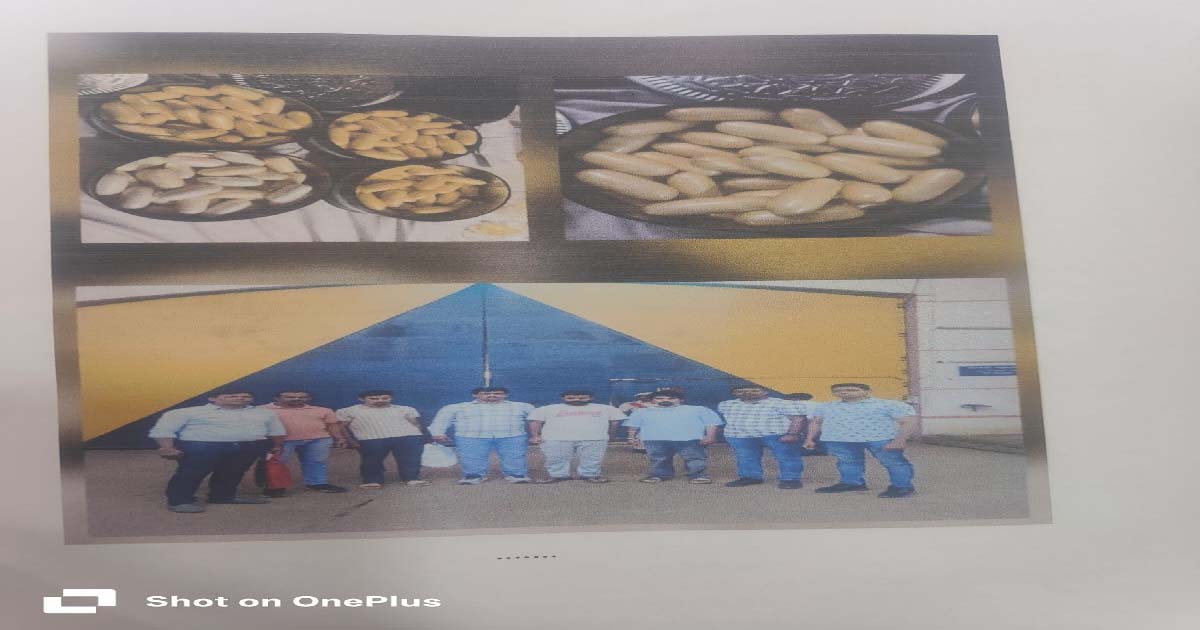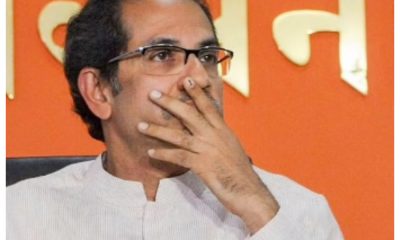Maharashtra
Maharashtra: For 2nd year, austere Ganeshotsav, sans crowds amid Covid fears

For the second consecutive year, millions of people in Mumbai, the coastal Konkan region and other parts of the state on Friday cheerfully welcomed Lord Ganesha amid stringent restrictions to ward off the lurking threats of the Covid-19 ‘third wave’.
The state’s biggest public festival’s lowkey celebrations were further hit by an abrupt change in the rules — banning all physical ‘darshan’ at the 2,400-odd public associations which have erected marquees (pandals) for devotees — disappointing the organisers.
“We were all geared to conduct the festival with full Covid-19 protocols but at the last-minute, the new rule with Sec. 144 has been clamped. This has come as a shock to all, but we shall strictly adhere to the government norms for public safety,” the BrihanMumbai Sarvajanik Ganeshutsav Samanway Samiti (BSGSS) President Naresh Dahibhavkar told IANS.
The missing crowds could entail huge losses of over Rs
100-crore for the public associations which had hoped to collect devotees offerings in their coffers besides sponsors and advertisers, for carrying out various charitable services round-the-year, rued Dahibhavkar.
Undaunted, the ordinary folks lustily chanting ‘Ganpati Bappa Morya’, started bringing the idols of their beloved lord since last night to their homes, housing societies, public or private complexes and associations, and virtually every household in villages, for the low-key but highly devotional celebrations over the next 10 days.
This morning, lakhs of families performed the ‘sthapna poojas’ followed by traditional ‘aartis’ to mark the birthday of Lord Ganesha, the son of Lord Shiva and Goddess Parvati.
On Saturday, a majority of the households would give the first send-off and perform the immersions of the Ganpati idols marking the one-and-half-day celebrations of the fest ending on September 19.
Considered the God of wisdom, the pot-bellied-elephant-headed Lord Ganesha brings in prosperity and good fortune and drives away obstacles (‘vigna’) and ill-luck.
This year also, the idol height is restricted to 4 feet for marquees and 2 feet for home worship — a significant drop from the pre-pandemic era when some of the majestic Lord Ganesha idols benignly stared down at devotees from 20-feet plus pinnacles.
Hoping to make the best of the austere celebrations, the BSGSS have decided to enhance their Covid-19 volunteer forces by at least 20 per cent to grapple the potential ‘third wave’, said Dahibhavkar.
“From tomorrow, we shall launch health campaigns, organise blood donations and other social activities in a planned manner to avoid crowds,” he added.
Celebrated across the country, the Mumbai-Pune-Nashik-Konkan quadrangle is the main epicentre of the festival with some of the biggest celebrations witnessed here annually.
Not willing to take any chances with the ‘third wave’ apparently round-the-corner, the government has permitted only ‘online’ darshans since even temples and other places of worship are shut as per the Centre’s directives.
“We have made all necessary arrangements for online darshans,” said actor Aadesh Bandekar, the Chairman of Shri SiddhiVinayak Mandir Trust, Mumbai, who is accorded the Minister of State (MoS) status.
The curbs notwithstanding, lakhs of idols of Lord Ganesha came to the homes of people, ranging from Chief Minister Uddhav Thackeray, ministers, Leaders of Opposition Devendra Fadnavis and Pravin Darekar, NCP President Sharad Pawar, state Congress President Nana Patole, city unit chief Bhai Jagtap, leaders of various parties, lawmakers and activists.
Lord Ganesha is also visiting top industrialists, film stars like Shah Rukh Khan, Salman Khan, Urmila Matondkar, Nana Patekar, Madhuri Dixit-Nene, the Kapoor clan, the Dutt family, and many more.
Maharashtra
Three men accused of robbing a youth have been arrested The main accused was apprehended in Titwala.

Mumbai: A young man returning home on a motorcycle in the Asalpha area of Ghatkopar was attacked and forcibly robbed by three men who brandished a chopper. A case was registered at the Ghatkopar police station under sections 309(4), 3(5) of the Indian Penal Code, sections 4, 25 of the Indian Penal Code, and sections 37(1) and 135 of the Indian Penal Code.
The complainant, Suraj Mahadev Dethe (24), and his friend, Yash Kamble, were passing near the Home Guard Training Center at approximately 1:30 a.m. on November 12th when three unidentified individuals in a three-wheeled tempo stopped them. The accused, using the chopper as a pointer, assaulted them, abused them, and stole their Honda Dio scooter and mobile phone.
As soon as the case was registered, the Assistant Commissioner of Police and Senior Police Inspector of the Ghatkopar Division inspected the scene. Based on technical and traditional investigations, the accused identified Hussain Aslam Memon, alias Genda. Upon receiving information that he was hiding in the Titwala area, the police apprehended him. During interrogation, he revealed the names of his accomplices – Munna Ramvilas Sharma and Dilshaduddin Sitabuddin Shaikh – who were subsequently arrested.
On November 13, the three accused were produced in court, where they were remanded to police custody until November 17. The investigation also revealed that Genda is a notorious criminal with more than 13 cases registered against him in various police stations.
Maharashtra
4-year-old girl kidnapped from Mumbai recovered from Varanasi after 6 months, Mumbai Police finds clues

Mumbai: Mumbai Police has succeeded in locating a 4-year-old girl after the Mumbai-Sholapur-CST train arrived in Mumbai. According to the details, the girl had come to Mumbai with her parents on May 20, 2025. During this time, an unknown person kidnapped the girl and took her from Mumbai to UP. After that, the police formed several teams to search for the girl and then one team was sent to Banaras. Here, the police took the help of social media and the media and made the girl’s picture viral. After that, a journalist told the police that there was a Marathi-speaking child in an orphanage here. After that, the police reached the place and confirmed it and brought the girl to Mumbai with documents on November 12. This operation was carried out by DCP Praveen Munde and the staff of M.A. Marg and Azad Maidan police on the instructions of Mumbai Police Commissioner Deven Bharti.
Maharashtra
Three smugglers arrested in Dongri Shabina Guest House drug smuggling case

Mumbai: After seizing three kilograms of cocaine from Shabina Guest House under the limits of Dongri Police Station, the police have claimed to have taken three drug peddlers into custody from Chennai Jail. According to the police, there was information about cocaine in Shabina Guest House here, on the basis of which on November 2, the police and ATC personnel conducted a raid and seized the drugs, the total value of which is estimated to be in crores. In this case, the police have registered a case under the NDPS Act. After this seizure, it was reported that this cocaine was smuggled from Ethiopia and South Africa by Tarun Kapoor, Sohail Ansari, Himanshu Shah and is lodged in Chennai Jail in a Narcotics Control Bureau case, on which the police have obtained the custody of these three accused and they have been formally arrested in this case. This operation was carried out under the guidance of Mumbai Police Commissioner Deven Bharti, DCP Praveen Munde and ACP Tanveer Shaikh.
-

 Crime3 years ago
Crime3 years agoClass 10 student jumps to death in Jaipur
-

 Maharashtra1 year ago
Maharashtra1 year agoMumbai Local Train Update: Central Railway’s New Timetable Comes Into Effect; Check Full List Of Revised Timings & Stations
-

 Maharashtra1 year ago
Maharashtra1 year agoMumbai To Go Toll-Free Tonight! Maharashtra Govt Announces Complete Toll Waiver For Light Motor Vehicles At All 5 Entry Points Of City
-

 Maharashtra1 year ago
Maharashtra1 year agoFalse photo of Imtiaz Jaleel’s rally, exposing the fooling conspiracy
-

 National News1 year ago
National News1 year agoMinistry of Railways rolls out Special Drive 4.0 with focus on digitisation, cleanliness, inclusiveness and grievance redressal
-

 Maharashtra1 year ago
Maharashtra1 year agoMaharashtra Elections 2024: Mumbai Metro & BEST Services Extended Till Midnight On Voting Day
-

 National News1 year ago
National News1 year agoJ&K: 4 Jawans Killed, 28 Injured After Bus Carrying BSF Personnel For Poll Duty Falls Into Gorge In Budgam; Terrifying Visuals Surface
-

 Crime1 year ago
Crime1 year agoBaba Siddique Murder: Mumbai Police Unable To Get Lawrence Bishnoi Custody Due To Home Ministry Order, Says Report














